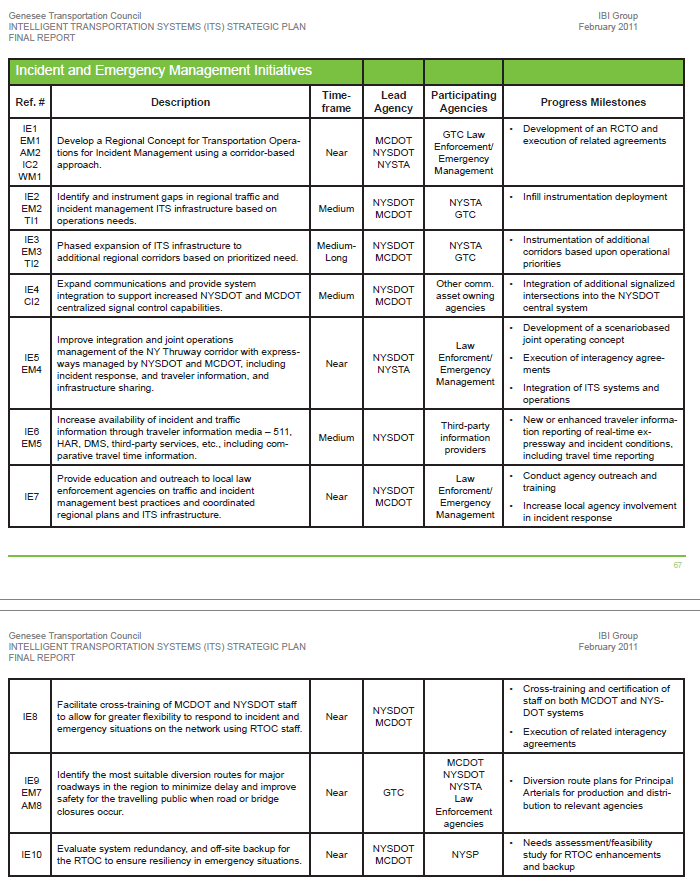Making the Connection: Advancing Traffic Incident Management in Transportation Planning
Appendix B. Case Study: A Metropolitan Transportation Plan and an Operations Plan Incorporating TIM
The purpose of this section is to illustrate how TIM can be integrated into a metropolitan transportation plan and its supporting planning documents by leading the reader through excerpts of the metropolitan transportation plan and the Intelligent Transportation Systems (ITS) Strategic Plan. The primary audience for this section is the planner who is interested in gathering tangible ideas for the structure and development of the plan in his or her region. The sample demonstrates one approach for making traffic incident management a priority for the region. While there are many options for where and how TIM can be integrated into a plan, the use of an objectives-driven, performance-based approach relies on specific, measureable objectives for TIM, TIM-related performance measures, and TIM strategies to meet those objectives. Because metropolitan transportation plans cover a broad range of areas such as public transportation, freight, safety, security, environment, land use, and social equity, the plan may not provide a detailed treatment of TIM. As shown in the example below, this region decided to use a supporting document, an ITS strategic plan, to capture multiple TIM objectives and performance measures and to describe the roles, responsibilities, and needs specific to TIM initiatives or programs. TIM may also be included in plans as part of an objectives-driven, performance-based congestion management process (CMP). Since incidents account for approximately 25% of congestion, it is appropriate for TIM to have a role in the CMP. Another common location for TIM strategies to appear in the plan is in a section dedicated to management and operations.
While many regions are quickly advancing toward a fully objectives-driven, performance-based approach to planning, the example below does not include performance targets for the TIM-related objectives and performance measures. This is an institutional and technical challenge that regions are working to address through the development of consistent definitions for performance measures, standard data collection procedures, and data sharing and integration. Annotations among the examples in this section offer options of targeted operations objectives to show how the integration of TIM in the plan could be taken to the next level.
Example: Genesee Transportation Council
The Genesee Transportation Council (GTC) is the MPO for the Genesee-Finger Lakes Region including the City of Rochester, New York. The region contains approximately 840,000 people over about 4,700 square miles. Since 2006, the MPO has facilitated a Transportation Management Committee that includes law enforcement, and it is working to bring in all public safety disciplines. In 2011, the region adopted an Intelligent Transportation Systems Strategic Plan for Greater Rochester25 and the 2035 Long Range Transportation Plan for the Genesee-Finger Lakes Region.26 While the long range plan includes TIM, the ITS strategic plan provides much greater depth on TIM.
Below are annotated excerpts from the long range plan that illustrate the incorporation of TIM.
The following excerpt shows the table of contents with annotations that highlight areas relevant for TIM.
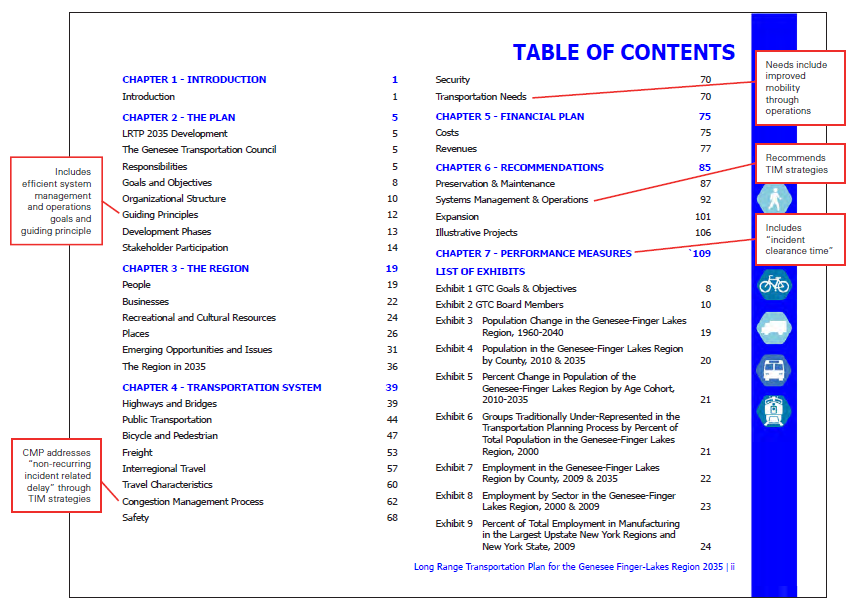

Congestion Management Process
The ability of the highway and bridge network to carry traffic efficiently and minimize delay to the travelling public and freight carriers is important to economic and social productivity as well as environmental quality. Time lost in traffic and increases in emissions of pollutants due to congestion are detrimental to quality of life and economic development. Even though the Genesee-Finger Lakes Region consistently ranks low in terms of congestion compared to similar sized areas in the nation, the U.S. Department of Transportation requires that Transportation Management Areas maintain a Congestion Management Process to:
- monitor and evaluate transportation system performance;
- identify alternative congestion mitigation actions;
- assess and implement cost-effective congestion mitigation actions; and
- evaluate the effectiveness of the implemented actions.
The objective of the GTC Congestion Management Process is to provide practical tools to identify and implement strategies that improve the mobility of people and freight, emphasizing coordinated corridor-level and region-wide solutions that mitigate existing sources and avoid the creation of future sources of congestion that result in excess delay.
Congestion that results in delay along the highway and bridge network of the region has been categorized into three types:
- Recurring Capacity Related Delay – results in trips taking longer during peak hours than during off-peak hours...
- Planned Event Related Delay – occurs as a result of a planned special event such as a concert, sports game or match, or scheduled road work...
- Non-Recurring Incident Related Delay – happens as a result of unplanned incidents such as an automobile crash or a severe weather event. This type of delay can occur anywhere on the transportation system, but is most likely to happen when an incident occurs on an already busy highway. According to the Texas Transportation Institute, incidents are estimated to cause between 52 and 58 percent of delay in all urban areas. Non- Recurring Incident Related Delay can be reduced through improved incident management such as quicker detection, response, and clearance times, as well as by using traveler information systems to help drivers avoid the incident scene altogether.
.
.
.
Locations that experience the greatest amount of Non-Recurring Incident Related Delay are those where volumes relative to the capacity of the roadway is nearing Recurring Capacity Related Delay and are more likely than other locations to experience crashes or other types of incidents that reduce the capacity of the roadway. The only location that is likely to be subject to Non-Recurring Incident Related Delay in the region outside of the Rochester TMA is located in the City of Batavia where NYS Routes 5, 33, 63, and 98 are in close proximity to each other in the heart of the City's central business district.
The GTC Congestion Mitigation Toolbox, ranging from constructing new highways to building and operating commuter rail, has been updated as part of the LRTP 2035. An evaluation of the benefits and costs of the strategies included in it relative to the guiding principles (discussed later) and the transportation needs of the region through 2035 (discussed previously) was conducted. Based on this evaluation, those mitigation strategies that are considered reasonable in the Genesee-Finger Lakes Region for each type of congestion are presented in Exhibit 18.
|
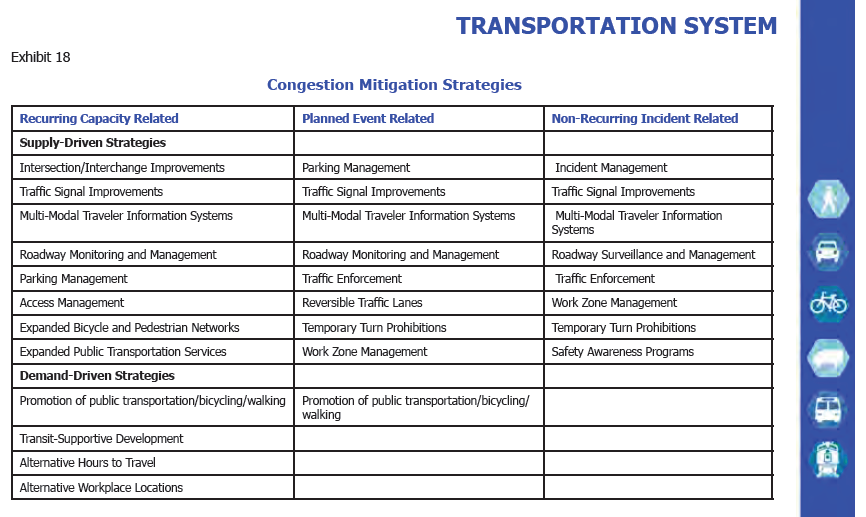

Systems Management and Operations
Transportation system management and operations (TSMO) recommendations provide the best opportunity to maximize the effectiveness of the current transportation system at the lowest cost. There are three primary initiatives that serve as the basis for the TSMO recommendations in the LRTP 2035: Technology, Coordination, and Demand. These initiatives are not mutually exclusive (e.g., there are Technology elements that are critical to and included in Coordination and Demand and the same is true for Coordination and Demand as they relate to Technology and each other).
The majority of delay in the region is non-recurring and is the result of crashes, weather, and other irregular events. TSMO programs and projects can effectively address non-recurring delay through improved incident response, more efficient deployment of resources to clear snow and ice, and timelier information to travelers. Even in cases where the delay is recurring due to peak demand and fixed capacity, TSMO programs and projects that inform travelers of less costly options that could be more convenient have the potential to reduce demand on the system when use is at its highest level.
TSMO programs and projects can increase safety by providing timely and accurate information to make travelers aware of hazards such as adverse weather conditions, work zones, crashes, and other incidents. By improving incident response and management, TSMO programs and projects can also shorten clearance times for crashes which reduce the likelihood of secondary crashes. This improves safety, reduces resulting delay and decreases emissions. The technologies used to monitor transportation system performance can also be used for homeland security purposes to prevent or respond to a terrorist attack, natural disaster, or other large-scale emergency.
.
.
.
Coordination
TSMO programs and projects also include the coordination of transportation infrastructure and services and the associated organizational relationships among all transportation agencies, including but not limited to NYSDOT, NYSTA, counties, the City of Rochester, and other municipalities. Like the design of infrastructure and services, the relationships between transportation agencies can also appreciably improve the safety, efficiency, and reliability of the transportation system.
How transportation agencies coordinate their respective activities can maximize the investment of public resources and the delivery of services that clear crashes, address weather-related consequences, and provide connections between public transportation services operated by public and not-for-profit providers. The structure of interagency collaboration between transportation, emergency management, and law enforcement entities is critical to efficient management and operation of the transportation system.
Formal protocols (including via Regional Concepts of Transportation Operations) to coordinate information sharing, incident response, and timing of construction projects based on a cooperatively- developed vision can improve efficiency and effectiveness.
Recommendations
- Continue federal funding for Regional Traffic Operations Center (RTOC) staffing, including continued 24-hour operations and cross-training of NYSDOT and Monroe County staff – Ongoing (Near-Term for cross-training)...
- Continue Federal funding for the NYSDOT Highway Emergency Local Patrol (HELP) Program to decrease delay and increase safety on major highways by providing emergency roadside service to disabled vehicles – Ongoing
The HELP Program is an important initiative in minimizing Non-Recurring Incident Related Delay. The program provides assistance to motorists that have experienced issues on major roadways that without quick action will limit capacity and cause congestion with the potential for secondary incidents as a result. The NYSDOT-Region 4 Advanced Transportation Management System Local Evaluation Report found that the HELP Program had one of the highest cost/benefit ratios of any initiative assessed. Like RTOC staffing, funding for the HELP Program has been and continues to be provided in the TIP and these financial resources will continue to be made available.
- Conduct relevant training opportunities between transportation, law enforcement, fire and medical, and other agencies to improve incident response, management, and clearance – Ongoing
Clearing crashes as quickly as possible while providing for the safety of emergency responders and law enforcement agents requires significant coordination. The National Highway Institute Coordinated Incident Management (Quick Clearance) Workshop, developed by the I- 95 Corridor Coalition, was conducted in October for regional local law enforcement, first responder, and transportation system management agencies, as well as representatives from the local towing industry. This workshop or a similar training opportunity should be offered in the region on a regular basis.
.
.
.
|
In Chapter 7, Performance Measures, GTC selected "median incident clearance time" as one of 15 performance measures that the region will use to monitor transportation system performance to support accountability and identify changes in key areas of the transportation system. A benchmark or current level is provided along with expected and desired directional changes.

Using quantitative metrics to measure the performance of the transportation system over time is important to being accountable to taxpayers, given the large amount of public funds used for its construction, maintenance, and operation. There is no current Federal or State requirement that system performance be monitored and reported but there are increasing discussions at the national level on this issue. Performance measures are included in the LRTP 2035 in order to monitor changes in key areas that matter to users of the transportation system.
GTC sought to ensure that the selected performance measures would be both meaningful (having significance) and understandable (capable of being comprehended) to users and policymakers, providing a common basis to discuss changes in how the transportation system is meeting or not meeting regional needs.
The current value for each performance measure is provided as a benchmark along with the desired direction consistent with the GTC Goals and Objectives and the likely direction based on what can realistically be accomplished within the reasonably expected revenues.
Though less important than meaningfulness and understandability, another consideration in the selection of the performance measures was the availability of quality data for the region (or Rochester TMA) and the likelihood that it will continue to be collected. As a result, all of the data is collected either by a GTC member agency, GTC staff, or a New York State government agency that is not a GTC member agency. Exhibit 26 presents the LRTP 2035 Performance Measures with each discussed below.
.
.
.
Median incident clearance time on major roadways was calculated by GTC for calendar year 2010 based on when notifications of incidents and their corresponding clearances were provided by e-mail through NY-Alert and the NYSTA TRANSalert.
|
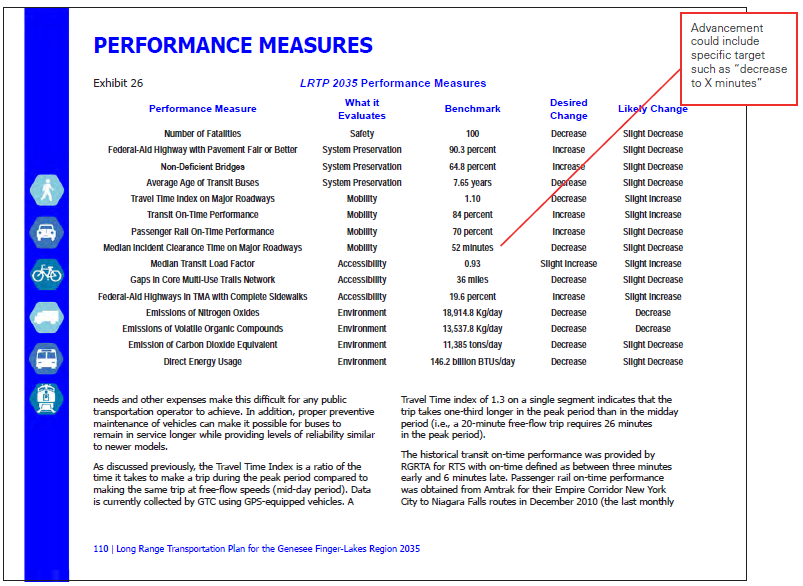
During the development of the region's long range transportation plan, GTC and its stakeholder agencies including public safety, created the Intelligent Transportation Systems (ITS) Strategic Plan for Greater Rochester. This served as a detailed plan for management and operations with a 10-year deployment strategy. The ITS strategic plan, guided by the regional vision and goals of the regional transportation plan, enabled transportation operators/public safety to provide crucial input on specific objectives, needs, and strategies for TIM. These needs and strategies were then used to build recommendations for TIM in the long range plan. The relationship between the regional transportation plan and the regional ITS strategic plan is diagramed in the figure below from the GTC ITS Strategic Plan.
Figure 4. Diagram depicting the relationship between regional transportation planning and planning for operations/ITS at the Genesee Transportation Council.

Source: Genesee Transportation Council, Intelligent Transportation Systems Strategic Plan for Greater Rochester, 2011. Available at: http://www.gtcmpo.org/Resources/Topics/TSMO.htm.
Below is an excerpt from the GTC ITS Strategic Plan of the incident and emergency management initiatives defined for the region. The objectives are activity or action-oriented and support the desired decrease in incident clearance time as identified in the long range plan.
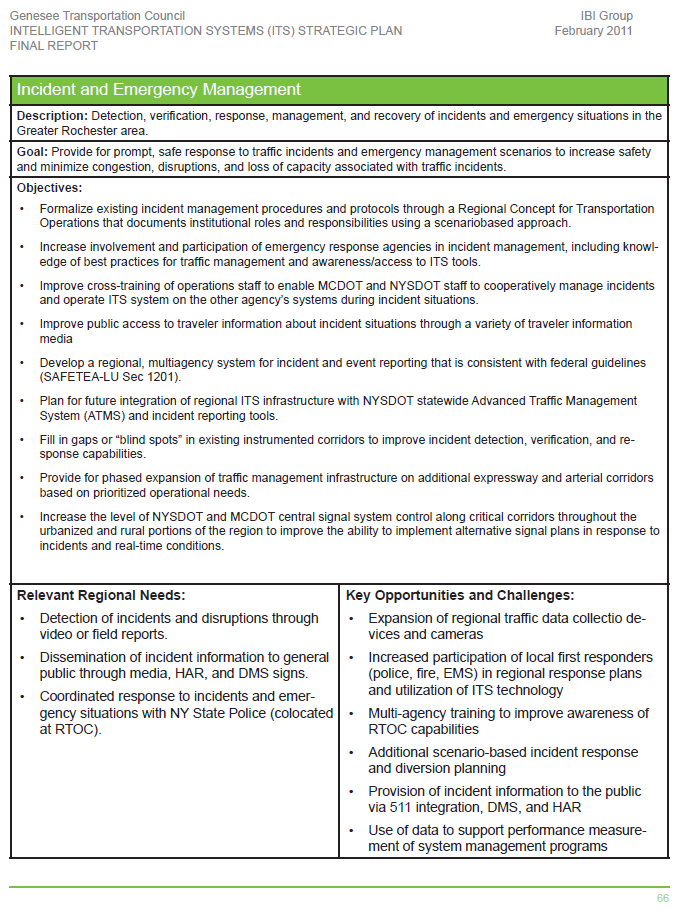
In the following table, lead and participating agencies include:
- GTC – Genesee Transportation Council
- MCDOT – Monroe County Department of Transportation
- NYSDOT – New York State Department of Transportation
- NYSTA – New York State Thruway Authority
